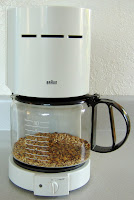Ingredients:
- 1 cup organic US two row base malt
- 1/3 cup English crystal 60L (or was it 40L?) malt
- Saaz hops, 2007, alpha 4.0
- Muntons active brewing yeast
Other than using slightly more malt I followed the mashing and lautering instructions exactly. The coffee pot holds the temperature at just under 160 degrees. This is all the grain the filter basket can hold. Mashed-in for for an hour, sparged six times, plus poured the wort over the grain one last time into the kettle. This whole process takes about an hour and a half.
Total of 8 cups of wort. The flavor is grainy and pleasant but not particularly sweet. The color is deep and opaque. I should have measured the boil gravity at this point.
I was surprised to see that the grain has visible sprouts. These I now know are called acrospires. It's kind of fun to see them rehydrate. The spent grain is not nearly as tasty, with the preponderance of base malt, as the crystal malt I used in the red ale.
Started the boil and added two hop pellets. Added six more after 20 minutes. Closing in on 40 minutes the wort volume was getting awfully low so I added a couple of cups of water. Added three more hop pellets at 45 minutes. Off heat after 55.
I have no idea what the quantity of hops was by weight. I don't have scale and did not get a pellet count before using in the first batch so I can't make a good estimate.
Cooled the kettle quickly in ice bath. This quantity took only 10 minutes or so to reach 70 degrees. Added some water to fermenter and poured wort. Aerated vigorously. Pitched rehydrated yeast, probably nearly half a packet, and aerated again.
At this point I did take a gravity reading and was shocked to see it somewhere between 1.012 and 1.014. The volume is only about 6 cups even with the water I added, so the wort should be more concentrated than what I started with. This must mean that not nearly enough sugars were extracted from the malt. The flavor is not much different than the original wort. Not getting much from the hops, either. The color is about what I would expect.
Poured into a 2 liter bottle fitted with a homemade cork and blowoff tube arrangement (I love those rare occasions where there's some benefit to being a pack rat) but I think it's unfermentable wort. After two days there wasn't a single CO2 bubble as far as I know. Update: I now know the cork/tube arrangement was not airtight so it's possible there was some CO2 production that I did not see.
After some reading I concluded that I did not come even close to adequately cracking the grain. The instructions about avoiding a marble rolling pin and gently applying pressure led me to really underdo it, I think.
I had less than 1/2 cup of grain left, but cracked it pretty thoroughly and made another smaller pot of wort. I didn't bother with exact measurements, but this wort was probably at twice the concentration as the first one. The gravity was only 1.020. I supplemented with three tablespoons of cane sugar, boiled with a few more hop pellets, combined with the first wort, and now have a gravity of 1.028 or so. I think this may give the yeast something to do.
So I'm left to wonder what theoretical maximum gravity is possible with this method. This is a very rough estimate since I didn't weigh the malt, but: I bought about 1/2 pound, used 4/3 cups, had perhaps 1/3 cup left over, so used about 2/5 pound of malt to produce 8 cups of wort, or 4/5 pound per gallon. If this were all 2-row pale ale malt with a maximum yield of 38 PPG and a 70% efficiency, which I think would be pretty good for homebrew procedures, then the yield would be 38 x .7 x .8 = 21.28, for a gravity of 1.021. Working backwards from OG of 1.014 at 6 cups the boil gravity would have been 1.0105 at 8 cups. That's an extract efficiency of 10.5 / 38 / .8 = 35%. Given that a fourth of the malt was crystal with a PPG of 34 rather than 38 and making large allowances for estimation error I'm willing to believe that this result is actually not an enormous surprise. I think I will try it again with properly crushed grist and careful measuring and see what kind of extract efficiency I can get. It's an interesting experiment.
I really don't know what to expect from my 6+ cups of fortified weak sauce. If it doesn't show signs of fermentation in the next couple of days I'll probably just dump it. I am very interested in figuring out how to do these nanobatches experimentally, so I do want to see how this simple carboy works. Probably gallon glass jugs are a better size and material, though.
A good kitchen scale is definitely on the to-buy list, as it sort of has been for years.










1 comment:
I bought this scale last summer for wine, beer, & cooking. Can't believe I went so long without.
$40 bucks at the brew supply store by U-Village.
http://www.escali.com/aqua.html
Post a Comment